MuseumScrabble A location-sensitive multiplayer mobile game
MuseumScrabble
A location-sensitive mobile game for competing teams of players.
Rules
The game is best described through an example:
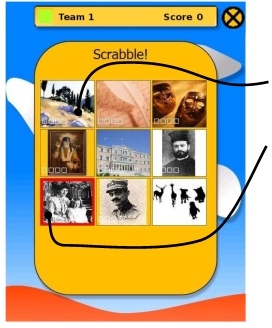 The game consists of two screens, the topic selection screen and the exhibit association screen. When the game starts, the player (Team 1, green color) sees the topic selection screen.
The game consists of two screens, the topic selection screen and the exhibit association screen. When the game starts, the player (Team 1, green color) sees the topic selection screen.
Each topic icon has for flags signalling availability of its hints. Here the game has just begun and the flags are empty; that means that the topics are available for scoring new points.
The player surveys the available topics and chooses the topic "Women of Zakynthos".
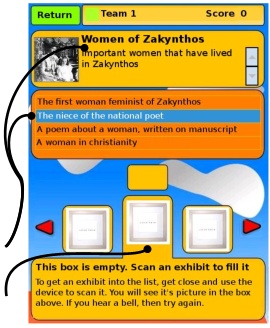 Having chosen a topic, the exhibit association screen is displayed. The player sees a short text describing the concept of the topic and beneath that, a list of up to four hints.
Having chosen a topic, the exhibit association screen is displayed. The player sees a short text describing the concept of the topic and beneath that, a list of up to four hints.
The player now has to look around in the museum and try to locate exhibits that might be relevant to the chosen topic and the available hints.
The way to do this is to search in the museum for exhibits and scan their tag with the handheld device. The scanned exhibit is then included in one of the available slots.
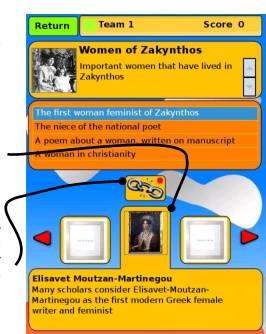 The player has now found the portrait of "Elisavet Moutzan-Martinegou" in a hall of the museum and has scanned its tag. The slot fills with a thumbnail picture of the exhibit and a short description appears on the screen.
The player has now found the portrait of "Elisavet Moutzan-Martinegou" in a hall of the museum and has scanned its tag. The slot fills with a thumbnail picture of the exhibit and a short description appears on the screen.
Once the slot is filled, the link/unlink icon appears and the player can link the exhibit with the selected hint by pressing the link/unlink icon.
An exhibit that has been scanned once in the slot can be used by the player in any topic. The number of available slots can be limited individually in different MuseumScrabble scenarios. When the slots are of small number and the player scans a new exhibit, she is prompted to choose whether to replace the one in the slot with the newly scanned.
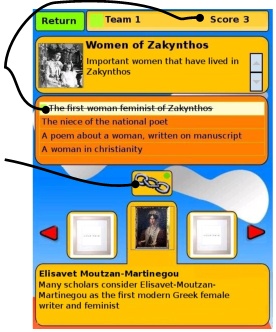 The player has now linked the exhibit with the first hint and gained 3 points. The hint is flagged with the player's color and is marked as taken. This means that the hint is no longer available for any other player.
The player has now linked the exhibit with the first hint and gained 3 points. The hint is flagged with the player's color and is marked as taken. This means that the hint is no longer available for any other player.
Only the current owner can release the hint now. If she does release it, she will loose the 3 points the hint is worth, and the hint will be available for the other players to associate with an exhibit.
The player can continue looking in the museum for exhibits that match the current topic or at any time return to the topic selection screen.
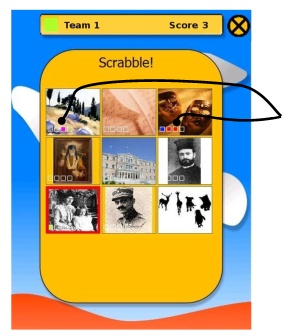
When the player returns to the topic screen, it is visible that the other teams have been also busy securing hints. This gives an overview of the other player's activity, but doesn't provide any information about their score. They might as well have created meaningless associations earning no points at all (but strategically locking hints).
The flags of the topic selection screen are updated instantly when an association has been made or released by any player. So, one can watch the screen and get an idea about the level of activity in each topic as the game continues.
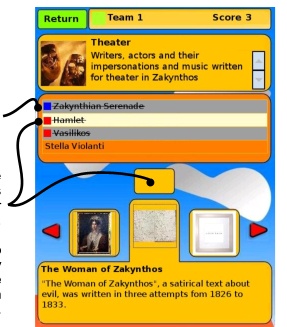 The exhibit association screen also shows the hints that have been taken by the other teams, by marking them with the owner's color. This screen is also updated instantly, so one can watch in real-time when the hints are associated and released.
The exhibit association screen also shows the hints that have been taken by the other teams, by marking them with the owner's color. This screen is also updated instantly, so one can watch in real-time when the hints are associated and released.
The player cannot associate and release hints that are owned by other players. But when a competitor releases a hint to try to associate it with another exhibit, the player may be watching and have the oppurtunity to grab it.
This version of the game concludes when there are no more hints available for association. Other versions may terminate after a specific amount of time has elapsed, or when one of the players reaches a certain score level first, or when all the hints are associated with the maximum score.